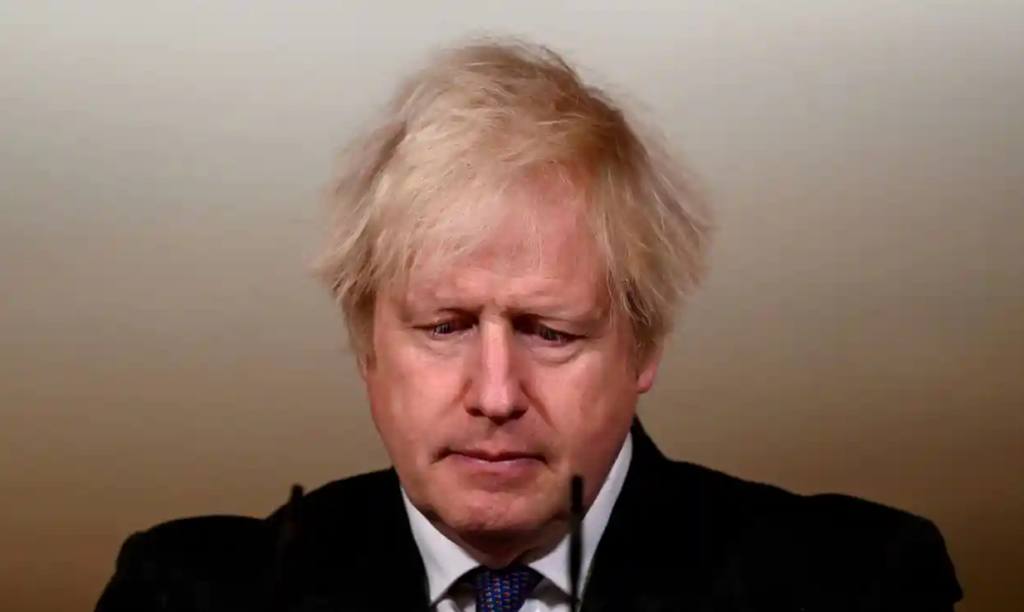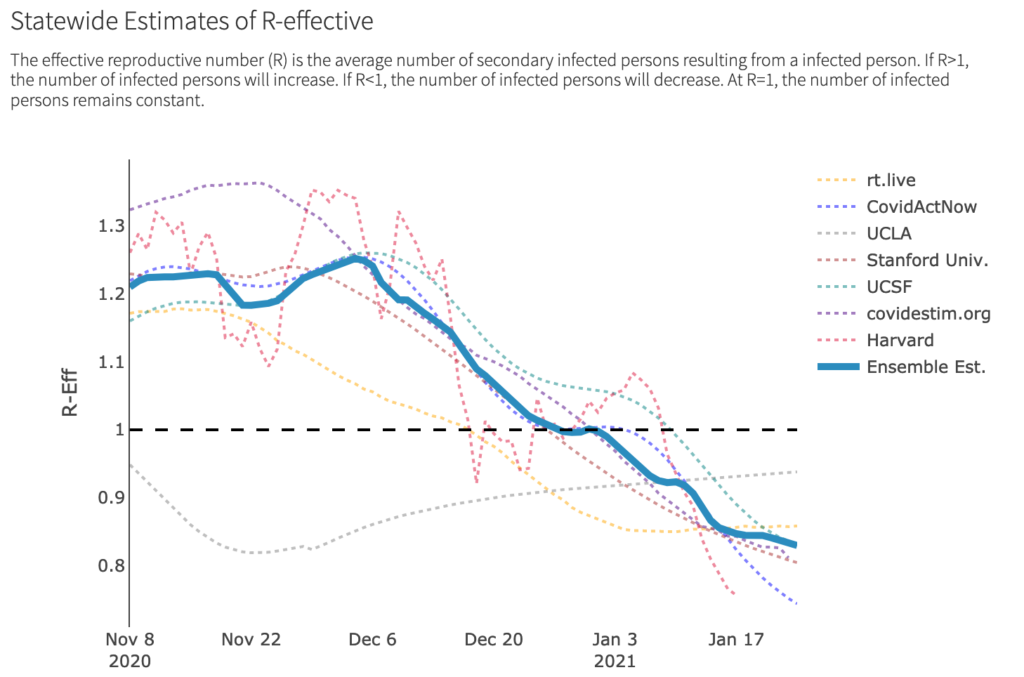A powerful man, looking harried and desperate for a win, is speaking to a digital scrum of reporters and members of the public. His constituents are tired of severe shutdown measures. He feels pressure mounting from all sides – but especially from corporate interests – to produce some good news. New daily Covid cases have fallen sharply and a key metric that tracks the disease’s spread has fallen far below the level at which new daily cases might be expected to grow in the coming days.
While admitting things are looking up and acknowledging the feelings of hope inspired by the still new vaccine rollout, he stops short of giving in to demands to relax restrictions. His administration, he says, will take a look at the matter in mid-February and not before. He concludes: “I think people want to see us making sure we don’t throw [recent progress] away by having a premature relaxation and then another big surge of infection.”
This man, as you are probably aware, is not California Governor Gavin Newsom. Rather, it is Boris Johnson, the conservative Prime Minister of the United Kingdom.

In Britain, Johnson’s remarks were seen as something of a gaffe. The P.M.’s suggestion that he might revisit lockdown measures some three weeks hence has been viewed as a sign that his resolve is weakening. But if Johnson’s actions merit derision, what response should Californians have for the much more bizarre conduct of their own government?
On Monday, Governor Newsom announced the immediate cessation of the stay-home order that had been mandated across the state for weeks in response to critical shortages in ICU beds and staff. It was an abrupt shift in policy, the breakneck speed of which was characterized by the complete failure of the government to communicate it through normal channels. Early word that Newsom was preparing to end the order disseminated first through the ranks of the California Restaurant Association over the weekend. Only as late as Sunday evening did it make its way to the press and social media.
Most members of the public, by contrast, were likely unaware that the change was coming until it had already arrived – on Monday morning. Among those apparently caught unaware was Eric Garcetti, mayor of the state’s largest city.
Newsom has been cagey about California’s rosy projections, which formed the entirety of the Governor’s case, for weeks now. The Associated Press reported just last week on the state’s unwillingness to release its models to the scrutiny of journalists, academics, or anyone else. Newsom’s administration adopted the position that more information would simply confuse Californians. But having thrown the master switch, Newsom had little choice but to provide some glimpse at the projection methodology that they have been using. After all, ICU capacity remains impacted at levels such that another surge would be a catastrophic reckoning in large portions of the state.

In a rambling presentation, Newsom claimed he would “illuminate” for people “what today means and [what] it doesn’t mean.” He then proceeded to say that the state’s numbers were trending positively and that there was no reason that they could think of not to undo the strict stay-home order.
In support of this, the Governor displayed formulas on a slide that apparently have yielded the prediction that within one month every region in the state would have plenty of ICU capacity to spare. The state gets from here to there, according to officials, because the R value has remained below 1 since around New Year’s Day. The R value, which has become a vaunted, much-watched indicator of progress in fighting against Covid, tells researchers how quickly or slowly the disease is spreading. Values under 1 mean that spread is slowing, while values over 1 mean the rate of spread is increasing.

While the falling R number is unreservedly good news, these policy decisions are not being made in isolation. The government’s policies create the future conditions in which the disease will or will not spread more easily. The R value that exists today, with stringent shelter-in-place restrictions and business closures, is not the same one that Californians should expect to see when regions begin reopening.
But things are actually worse than that. As with so many of the figures that society has become familiar with during the course of the pandemic, the R value is a lagging indicator. It is not a measure of how many individuals a sick person today is infecting. Rather it measures how many individuals a sick person weeks ago would have had to infect for there to be as many sick people as there are today.
And that makes sense, because a big part of the reason viruses spread so easily is that it is simply difficult to know who is infected at the present moment. As a result, and bear with me here, scientists create tools called nowcasts to “predict” what is happening currently. A nowcast is a forecast for the present; since they would have to wait weeks to have all the information they need to produce an R value for today, they predict what those other numbers might be two weeks from now.
There is always uncertainty inherent in these activities. No one knows the future. But by staying closer to the present, predictions can have a greater degree of confidence that most other variables – human behavior is a big one, particularly at society-wide scales – might be relatively constant.
This is where it counts: Governor Newsom’s government has thrown caution (not to mention the safety of tens of millions of people) to the wind. The charts Newsom presented show a difficult-to-believe linear decrease in ICU capacity extending an incredible four weeks into the future. In order to do this, Newsom’s formulas show, they are using the current day value of R and keeping it constant as they project how many people will need to be admitted to ICUs.
This sort of compounded predictive analysis should make Californians nervous. Taking the output of a prediction and using it as the input for a new, further-out prediction clearly poses the threat that the government is merely creating a primrose path for itself, one that is gradually becoming more and more divorced from reality. This danger is underlined by the fact that the current-day value of R is not a known quantity – but is rather a prediction itself. So, in order to get a prediction a month in advance, the government is actually attempting to predict the numbers that can be used to generate the R value up to six weeks in advance. For this to serve as the basis for a major policy shift affecting 40 million Californians with no notice is simply irresponsible.
Furthermore, Californians must recall that very little is known at this time about the U.K. Covid variant or about its prevalence in California. The variant has been identified in Southern California and it is believed to be significantly more transmissible than the currently-dominant strain of the disease. If or when the U.K. variant is able to gain a foothold within the state, the government should be preparing to see a radical shift in the R value observed here. As the new variant squeezes out the old one, transmissibility will shift to reflect the more contagious version.
Instead of cautious optimism, Governor Newsom has directed his administration to stop on a dime. Reverting to an earlier stage of California’s pandemic response, individual counties will now return to being able to exercise greater autonomy in allowing businesses to reopen. As in the past, this decision will undoubtedly release a new wave of buck passing from state to local elected officials. Already, multiple Los Angeles Supervisors have indicated that they will bring the county into “alignment” with the state’s guidance, which is to say, they will take advantage of the opportunity to reopen businesses. That includes a scheduled reopening for outdoor dining on Friday.
The case of the U.K. offers a pronounced contrast to the recent news out of California. While both governments enacted lockdowns in the face of devastating surges, California and Britain have both more recently seen case levels fall. The lockdowns have been even more successful in Britain, where, on a per capita basis, new daily cases are much lower than in California. R values are also similar in both places, having declined from well over a value of 1 a month ago to between .8 and 1 today. Nonetheless, as mentioned, while the U.K. government remains committed (even if not without reservation) to preventing a deadly backslide, California is again throwing the doors open wide, come what may.
